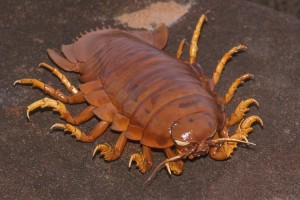Monster Monday: the Giant Isopod
Monday, November 28th, 2016November 28, 2016
This week’s Monday monster may look oddly familiar. Perhaps you’ve seen a much smaller version of this buglike creature in your backyard on a rotting tree stump or under a rock. Those little critters are commonly called pill bugs, roly polies, sow bugs, or wood lice. But today, meet the giant isopod (Bathynomus giganteus)—this roly poly can grow as big as a small dog!

This creepy giant isopod (Bathynomus giganteus) measures a foot (30 centimeters) long! Credit: © Jany Sauvanet, Photo Researchers
The giant isopod stalks the inky darkness of the ocean floor between about 500 feet (150 meters) and more than 7,000 feet (2,100 meters) below the surface. Like its land-dwelling cousin, the pill bug, the giant isopod is actually a crustacean, more similar to animals like shrimp and crabs than insects. Regardless, giant isopods are an intimidating sight, growing as large as 2.5 feet (0.75 meters) in length, with huge compound eyes that glow with reflected light, seven pairs of spiny legs, and two full sets of ravenous jaws. The enormous size of the giant isopod is an example of what biologists call deep sea gigantism. This is the tendency of deep sea creatures to grow much larger than their smaller relatives found in shallow waters or on land.
Giant isopods are mainly concerned with their next meal, wherever and whatever that may be. They have two full pairs of sharp jaws they use to cut and tear into their food. They are deep ocean scavengers that greedily attack and gorge themselves on fish carcasses, decaying plant matter, or even feces (solid waste) that falls to the ocean floor. These are unpredictable sources of food, however, so meals may be few and far between. But these crustaceans have a very slow metabolism, which means they expend little energy and can go a long time without eating. One giant isopod on exhibit at the Public Aquarium in Nagoya, Japan, was especially finicky. It went without eating for five years!
The first giant isopod was collected by Swiss-born scientist Alexander Agassiz after a specimen was dredged up from the bottom of the Gulf of Mexico in 1879. At that time, most scientists thought the deep ocean was azoic (without life). They did not believe animals could survive in the cold, oxygen-poor darkness hundreds of feet below the surface. Today, scientists know that millions of different organisms live at the bottom of the world’s oceans. Some are even stranger and creepier than the giant isopod!


